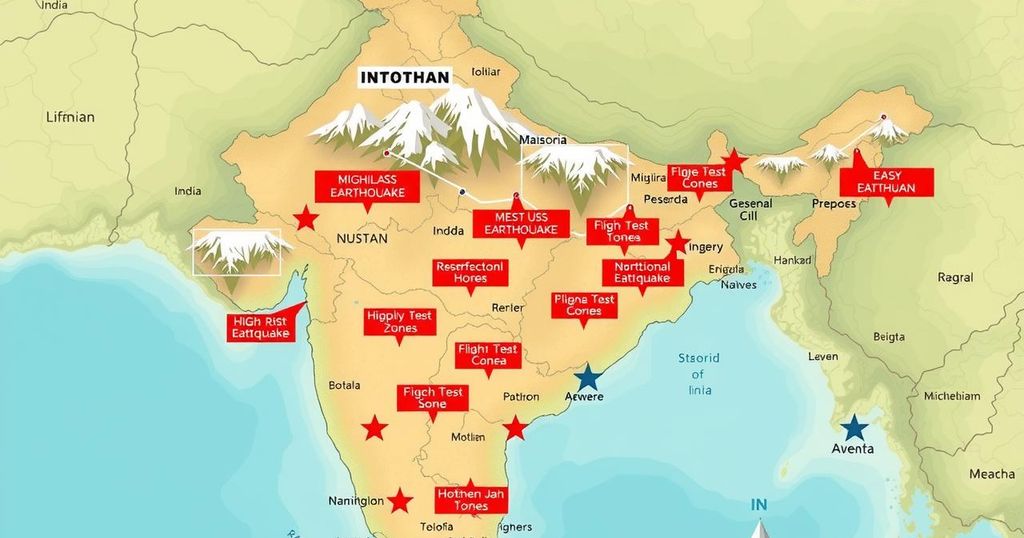Preparedness for the Inevitable: India’s Earthquake Risk and Solutions

India is at high risk for a major earthquake from the Himalayas, which could significantly impact urban centers like Delhi and Mumbai. Vulnerable infrastructure and inadequate building codes heighten the danger. Only through immediate action, including strict enforcement of safety regulations and community preparedness education, can the potential for mass casualties be reduced. An upcoming earthquake is inevitable, and preparations are critical.
India’s population faces a looming threat from a potential “Great Himalayan Earthquake” that could reach a magnitude of 8 or more. Scientists have been warning about this for decades, underscoring that a significant quake is only a matter of time. The Himalayan region, particularly northern India, is nearing a critical point where accumulated tectonic stress will suddenly release, leading to catastrophic results.
Research indicates that India shifts approximately 2 meters beneath the southern edge of Tibet every century. According to Roger Bilham, an American geophysicist, this friction prevents smooth tectonic movement, building up pressure for centuries until it is violently released as an earthquake. Without a major quake for over 70 years, the risk of a destructive seismic event in the Himalayas continues to escalate.
A significant portion of India—approximately 59%—is at risk for earthquakes, with high-risk zones located in Himachal Pradesh, Uttarakhand, Bihar, and the Northeast region. Major metropolitan areas like Delhi, Mumbai, and Kolkata, which lie on unstable fault lines, are especially vulnerable. Delhi, classified as a Seismic Zone IV area due to its proximity to the Delhi-Hardwar Ridge, has already experienced tremors, raising public concern about preparedness for a major quake.
In India, the construction of buildings often poses a greater risk than the earthquakes themselves due to inadequate adherence to earthquake-resistant codes. Despite regulations in place, many builders circumvent these safety measures, creating high-risk structures. Essential facilities such as hospitals and schools frequently remain inadequate for withstanding seismic events, increasing the probability of mass casualties during an earthquake.
Countries like Japan and Chile have implemented rigorous earthquake preparedness and infrastructure regulations, which help them endure seismic events better than India. However, in India, the cycle of initial response to disasters is often followed by a return to complacency, undermining long-term safety strategies. Experts argue that this needs to change to prevent future tragedies when a major quake does occur.
To improve earthquake safety, India must prioritize action over knowledge. The Bureau of Indian Standards (BIS) holds earthquake-resilient codes that are often ignored, emphasizing the need for enforcement and accountability. Regular structural audits by trained professionals, partnerships with educational institutes, and mentorship programs could help create a workforce equipped to address seismic safety.
Many existing buildings, particularly older structures, are dangerously vulnerable and must be retrofitted without delay. Additionally, urban planning must include reinforcement of key infrastructure and the allocation of open spaces for safe evacuations. Education around earthquake preparedness is essential, and regular drills should be conducted in workplaces and schools to enhance community readiness.
Bilham warns that the next Himalayan earthquake, potentially between magnitudes 8.2 and 8.9, could be unprecedented because it will occur on land, affecting densely populated areas. Unlike tsunamis that strike coastal regions, a land-based earthquake poses a unique threat to India’s economic centers.
The experience of recent disasters, such as the Myanmar tragedy, serves as a critical reminder. To mitigate the potentially high loss of life, India must take decisive action now. Recognizing the inevitability of future earthquakes, systemic preparedness will be key to reducing casualties and damage in the face of impending seismic threats.
India faces an imminent threat from a potential “Great Himalayan Earthquake” that could impact 300 million people. With key regions at high risk and existing infrastructure lacking compliance with safety regulations, urgent action is necessary. By enforcing building codes, conducting regular audits, and educating the population on preparedness, India can lessen the devastating consequences of such a seismic event. The time to act is now, focusing on readiness to avert mass casualties in the future.
Original Source: m.economictimes.com







